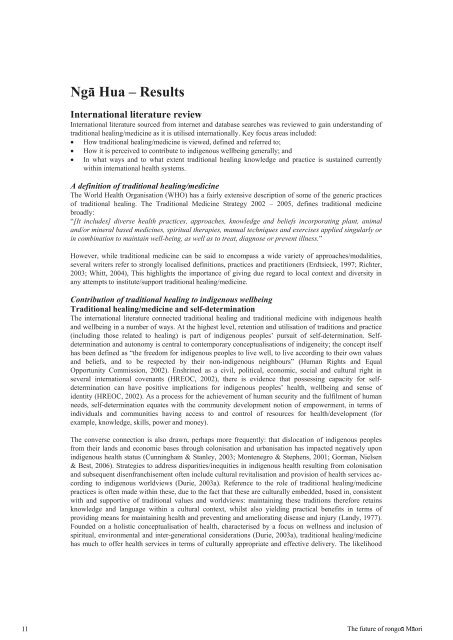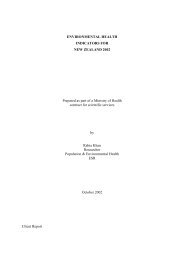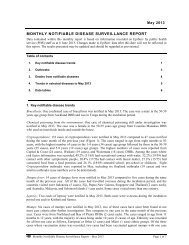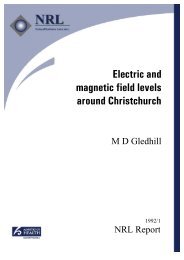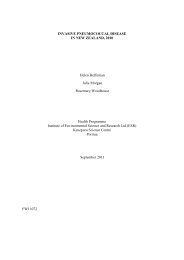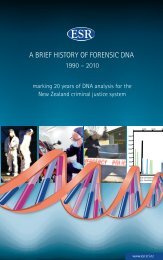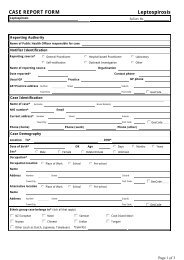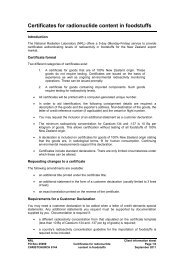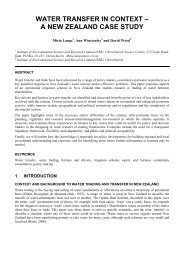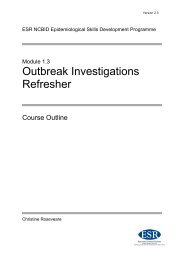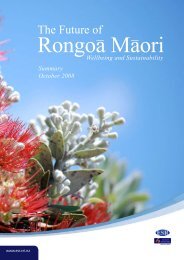The future of rongoÄ MÄori: wellbeing and ... - LIME Network
The future of rongoÄ MÄori: wellbeing and ... - LIME Network
The future of rongoÄ MÄori: wellbeing and ... - LIME Network
You also want an ePaper? Increase the reach of your titles
YUMPU automatically turns print PDFs into web optimized ePapers that Google loves.
Ng Hua – Results<br />
International literature review<br />
International literature sourced from internet <strong>and</strong> database searches was reviewed to gain underst<strong>and</strong>ing <strong>of</strong><br />
traditional healing/medicine as it is utilised internationally. Key focus areas included:<br />
How traditional healing/medicine is viewed, defined <strong>and</strong> referred to;<br />
How it is perceived to contribute to indigenous <strong>wellbeing</strong> generally; <strong>and</strong><br />
In what ways <strong>and</strong> to what extent traditional healing knowledge <strong>and</strong> practice is sustained currently<br />
within international health systems.<br />
A definition <strong>of</strong> traditional healing/medicine<br />
<strong>The</strong> World Health Organisation (WHO) has a fairly extensive description <strong>of</strong> some <strong>of</strong> the generic practices<br />
<strong>of</strong> traditional healing. <strong>The</strong> Traditional Medicine Strategy 2002 – 2005, defines traditional medicine<br />
broadly:<br />
“[It includes] diverse health practices, approaches, knowledge <strong>and</strong> beliefs incorporating plant, animal<br />
<strong>and</strong>/or mineral based medicines, spiritual therapies, manual techniques <strong>and</strong> exercises applied singularly or<br />
in combination to maintain well-being, as well as to treat, diagnose or prevent illness.”<br />
However, while traditional medicine can be said to encompass a wide variety <strong>of</strong> approaches/modalities,<br />
several writers refer to strongly localised definitions, practices <strong>and</strong> practitioners (Erdtsieck, 1997; Richter,<br />
2003; Whitt, 2004), This highlights the importance <strong>of</strong> giving due regard to local context <strong>and</strong> diversity in<br />
any attempts to institute/support traditional healing/medicine.<br />
Contribution <strong>of</strong> traditional healing to indigenous <strong>wellbeing</strong><br />
Traditional healing/medicine <strong>and</strong> self-determination<br />
<strong>The</strong> international literature connected traditional healing <strong>and</strong> traditional medicine with indigenous health<br />
<strong>and</strong> <strong>wellbeing</strong> in a number <strong>of</strong> ways. At the highest level, retention <strong>and</strong> utilisation <strong>of</strong> traditions <strong>and</strong> practice<br />
(including those related to healing) is part <strong>of</strong> indigenous peoples’ pursuit <strong>of</strong> self-determination. Selfdetermination<br />
<strong>and</strong> autonomy is central to contemporary conceptualisations <strong>of</strong> indigeneity; the concept itself<br />
has been defined as “the freedom for indigenous peoples to live well, to live according to their own values<br />
<strong>and</strong> beliefs, <strong>and</strong> to be respected by their non-indigenous neighbours” (Human Rights <strong>and</strong> Equal<br />
Opportunity Commission, 2002). Enshrined as a civil, political, economic, social <strong>and</strong> cultural right in<br />
several international covenants (HREOC, 2002), there is evidence that possessing capacity for selfdetermination<br />
can have positive implications for indigenous peoples’ health, <strong>wellbeing</strong> <strong>and</strong> sense <strong>of</strong><br />
identity (HREOC, 2002). As a process for the achievement <strong>of</strong> human security <strong>and</strong> the fulfilment <strong>of</strong> human<br />
needs, self-determination equates with the community development notion <strong>of</strong> empowerment, in terms <strong>of</strong><br />
individuals <strong>and</strong> communities having access to <strong>and</strong> control <strong>of</strong> resources for health/development (for<br />
example, knowledge, skills, power <strong>and</strong> money).<br />
<strong>The</strong> converse connection is also drawn, perhaps more frequently: that dislocation <strong>of</strong> indigenous peoples<br />
from their l<strong>and</strong>s <strong>and</strong> economic bases through colonisation <strong>and</strong> urbanisation has impacted negatively upon<br />
indigenous health status (Cunningham & Stanley, 2003; Montenegro & Stephens, 2001; Gorman, Nielsen<br />
& Best, 2006). Strategies to address disparities/inequities in indigenous health resulting from colonisation<br />
<strong>and</strong> subsequent disenfranchisement <strong>of</strong>ten include cultural revitalisation <strong>and</strong> provision <strong>of</strong> health services according<br />
to indigenous worldviews (Durie, 2003a). Reference to the role <strong>of</strong> traditional healing/medicine<br />
practices is <strong>of</strong>ten made within these, due to the fact that these are culturally embedded, based in, consistent<br />
with <strong>and</strong> supportive <strong>of</strong> traditional values <strong>and</strong> worldviews: maintaining these traditions therefore retains<br />
knowledge <strong>and</strong> language within a cultural context, whilst also yielding practical benefits in terms <strong>of</strong><br />
providing means for maintaining health <strong>and</strong> preventing <strong>and</strong> ameliorating disease <strong>and</strong> injury (L<strong>and</strong>y, 1977).<br />
Founded on a holistic conceptualisation <strong>of</strong> health, characterised by a focus on wellness <strong>and</strong> inclusion <strong>of</strong><br />
spiritual, environmental <strong>and</strong> inter-generational considerations (Durie, 2003a), traditional healing/medicine<br />
has much to <strong>of</strong>fer health services in terms <strong>of</strong> culturally appropriate <strong>and</strong> effective delivery. <strong>The</strong> likelihood<br />
11<br />
<strong>The</strong> <strong>future</strong> <strong>of</strong> rongo Mori<br />
11 <strong>The</strong> <strong>future</strong> <strong>of</strong> rongoa Maori


